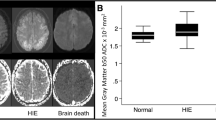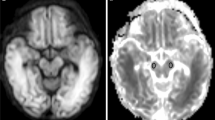Abstract
The purpose of our study was to determine the usefulness of echo-planar diffusion-weighted imaging (EPDI) in the evaluation of watershed hypoxic-ischemic brain injury in pediatric patients. Eighteen patients ranging in age from 3 weeks to 12 years were evaluated for evidence of ischemic/infarction changes on conventional MR and EPDI. Included in the study group were five patients with sickle cell disease, four with congenital heart disease, four with hypotensive episodes with various etiologies, three with sepsis, and two with encephalitis or meningitis. Patients were examined 2 h to 6 days after the initial insult, with follow-up studies in four patients at 1 to 62 days after the initial examination. After conventional MR imaging (T1, FSE T2, and FLAIR), diffusion-weighted MR imaging was performed using high-speed, single-shot EP techniques with TR 6000, TE 144, matrix 96 × 128, FOV 23.3 × 31 and five b values of 0, 160, 360, 640, and 1,000 s/mm2. EPDI demonstrated abnormally increased signal in watershed ischemic/infarction zones in all initial cases. Apparent diffusion coefficients (ADC) were obtained in 59 lesions. When compared with radiographically normal (on EPDI) contralateral brain parenchyma, 45 demonstrated a relatively decreased ADC, while eight had normal ( ± 10 %) and six had increased ADC. In four cases, signal abnormalities on EPDI were not seen or exceeded that seen with conventional MR imaging. In the remaining cases, signal abnormalities were obvious on EPDI and more subtle on conventional MR imaging. Follow-up studies demonstrated resolution of abnormal EPDI signal with persistent abnormalities on conventional imaging in some cases, while others revealed an increase in size or number of EPDI signal abnormalities, suggesting ongoing acute ischemic/infarctive changes. EPDI is a rapid, sensitive technique for detecting watershed ischemic/infarction changes in pediatric patients with hypoperfusion episodes, at times before such changes are apparent on conventional MR images and/or are clinically apparent.
Similar content being viewed by others
Author information
Authors and Affiliations
Additional information
Received: 5 January 2001/Accepted: 1 February 2001
Rights and permissions
About this article
Cite this article
Liu, A., Zimmerman, R., Haselgrove, J. et al. Diffusion-weighted imaging in the evaluation of watershed hypoxic-ischemic brain injury in pediatric patients. Neuroradiology 43, 918–926 (2001). https://doi.org/10.1007/s002340100605
Published:
Issue Date:
DOI: https://doi.org/10.1007/s002340100605




